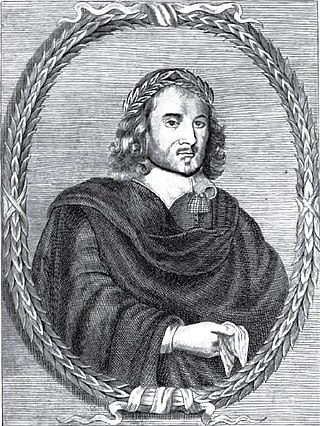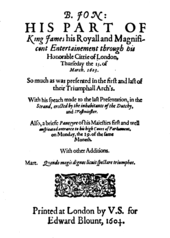
Benjamin Jonson was an English playwright and poet. Jonson's artistry exerted a lasting influence on English poetry and stage comedy. He popularised the comedy of humours; he is best known for the satirical plays Every Man in His Humour (1598), Volpone, or The Fox, The Alchemist (1610) and Bartholomew Fair (1614) and for his lyric and epigrammatic poetry. He is regarded as "the second most important English dramatist, after William Shakespeare, during the reign of James I."

Thomas Middleton was an English Jacobean playwright and poet. He, with John Fletcher and Ben Jonson, was among the most successful and prolific of playwrights at work in the Jacobean period, and among the few to gain equal success in comedy and tragedy. He was also a prolific writer of masques and pageants.

The Masque of Blackness was an early Jacobean era masque, first performed at the Stuart Court in the Banqueting Hall of Whitehall Palace on Twelfth Night, 6 January 1605. It was written by Ben Jonson at the request of Anne of Denmark, the queen consort of King James I, who wished the masquers to be disguised as Africans. Anne was one of the performers in the masque along with her court ladies, all of whom appeared in blackface makeup. In a ceremony earlier on the day, Prince Charles, Anne's second son was given the title of Duke of York.

Ben Jonson collected his plays and other writings into a book he titled The Workes of Benjamin Jonson. In 1616 it was printed in London in the form of a folio. Second and third editions of his works were published posthumously in 1640 and 1692.
Love Freed from Ignorance and Folly was a Jacobean era masque, written by Ben Jonson and designed by Inigo Jones, with music by Alfonso Ferrabosco. It was performed on 3 February 1611 at Whitehall Palace, and published in 1616.
Love Restored was a Jacobean era masque, written by Ben Jonson; it was performed on Twelfth Night, 6 January 1612, and first published in 1616. The Dictionary of National Biography says of the masque, "This vindication of love from wealth is a defense of the court revels against the strictures of the puritan city."
The Golden Age Restored was a Jacobean era masque, written by Ben Jonson and designed by Inigo Jones; it was performed on 1 January and 6 January 1616, almost certainly at Whitehall Palace.
Mercury Vindicated from the Alchemists at Court is a Jacobean-era masque, written by Ben Jonson and designed by Inigo Jones. It was performed at Whitehall Palace on Twelfth Night, 6 January 1615. King James I liked it so much that he ordered a repeat performance the following Sunday, 8 January.
The Fortunate Isles and Their Union is a Jacobean era masque, written by Ben Jonson and designed by Inigo Jones, and performed on 9 January 1625. It was the last masque acted before King James I of England, and therefore the final masque of the Jacobean era.
Neptune's Triumph for the Return of Albion was a Jacobean era masque, written by Ben Jonson, and designed by Inigo Jones. The masque is notable for the contradictory historical evidence connected with it and the confusion it caused among generations of scholars and critics.
The Entertainment at Althorp, or The Althorp Entertainment, performed on 25 June 1603 is an early Jacobean era literary work, written by Ben Jonson. It is also known as A Particular Entertainment of the Queen and Prince, or The Satyr. The work marked a major development in Jonson's career, as the first of many entertainments and masques that he would write for the Stuart Court.
The Masque of the Inner Temple and Gray's Inn, also known as, The Masque of the Olympic Knights, is an English masque created in the Jacobean period. It was written by Francis Beaumont and is known to have been performed on 20 February 1613 in the Banqueting House at Whitehall Palace, as part of the elaborate wedding festivities surrounding the marriage of Princess Elizabeth, the daughter of King James I, to Frederick V, Elector Palatine.
The Masque of Augurs was a Jacobean era masque, written by Ben Jonson and designed by Inigo Jones. It was performed, most likely, on Twelfth Night, 6 January 1622.
Time Vindicated to Himself and to his Honours was a late Jacobean era masque, written by Ben Jonson and with costumes, sets, and stage effects designed by Inigo Jones. James's son and heir Prince Charles led the dances of the principal masquers, as he had in several previous masques at the Stuart Court.

The Vision of the Twelve Goddesses was an early Jacobean-era masque, written by Samuel Daniel and performed in the Great Hall of Hampton Court Palace on the evening of Sunday, 8 January 1604. One of the earliest of the Stuart Court masques, staged when the new dynasty had been in power less than a year and was closely engaged in peace negotiations with Spain, The Vision of the Twelve Goddesses stood as a precedent and a pattern for the many masques that followed during the next four decades.
Luminalia or The Festival of Light was a late Caroline era masque or "operatic show", with an English libretto by Sir William Davenant, designs by Inigo Jones, and music by composer Nicholas Lanier. Performed by Queen Henrietta Maria and her ladies in waiting on Shrove Tuesday, 6 February 1638, it was one of the last and most spectacular of the masques staged at the Stuart Court.
The Gypsies Metamorphosed, alternatively titled The Metamorphosed Gypsies, The Gypsies' Metamorphosis, or The Masque of Gypsies, was a Jacobean era masque written by Ben Jonson, with music composed by Nicholas Lanier. It was first performed on 3 August 1621, and was the biggest popular hit of Jonson's masquing career.
Lovers Made Men, alternatively titled The Masque of Lethe or The Masque at Lord Hay's, was a Jacobean era masque, written by Ben Jonson, designed by Inigo Jones, and with music composed by Nicholas Lanier. It was performed on Saturday 22 February 1617, and was significant in the development and acceptance of opera in seventeenth-century England.
Pan's Anniversary, or The Shepherd's Holiday was a Jacobean era masque, written by Ben Jonson and designed by Inigo Jones. The date of the masque's performance at the English Court has long been in dispute: while the earliest text assigns it to 1625, mid-twentieth-century scholars placed it on 19 June 1620, the king's birthday, at the royal palace at Greenwich. More recently, Martin Butler has argued for a date of 6 January 1621.
Nicholas Okes was an English printer in London of the Jacobean and Caroline eras, remembered for printing works of English Renaissance drama. He was responsible for early editions of works by many of the playwrights of the period, including William Shakespeare, Ben Jonson, John Webster, Thomas Middleton, Thomas Dekker, Thomas Heywood, James Shirley, and John Ford.





